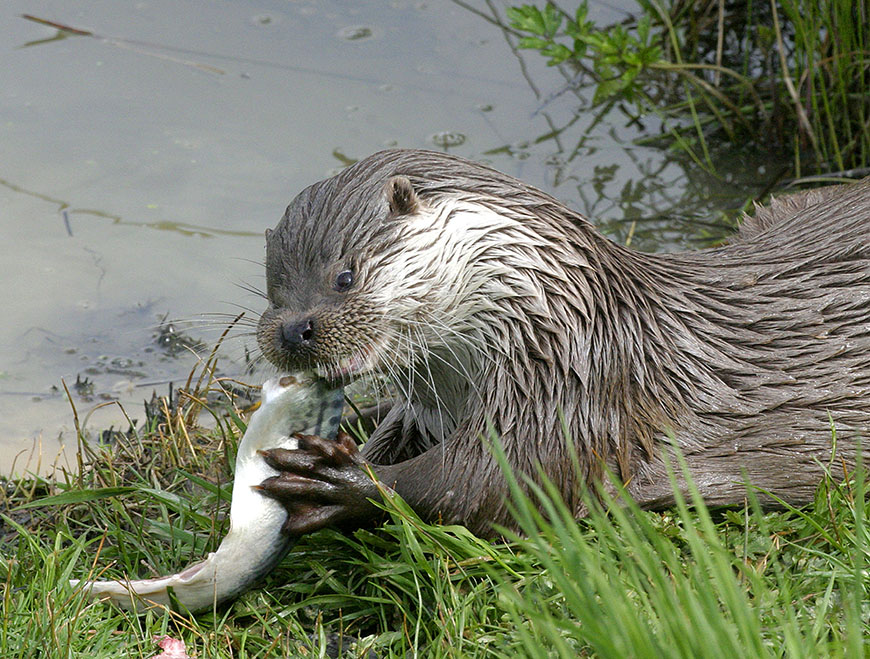Our great outdoors is full of colour now that summer is taking hold while the main breeding season has well and truly kicked in.
June and July are the best times for seeing the 21 beautiful orchid species that grow in the North York Moors. You'll most likely see the common spotted orchid, with its delicate pale pink flower spikes which grows in many different areas. If you're keen to see more of the other species, join Yorkshire Coast Nature on one of its wildflower tours.
A little further to the east, Yorkshire Wildlife Trust's Wharram Quarry reserve is a former chalk quarry home to pyramidal and spotted-orchids and sometimes an abundant display of bee orchids, whose flowers mimic bees to attract pollinators.
Our tip
Otters living on the rivers Derwent, Rye, Dove and Esk will be very active now, supporting their fast growing cubs.
A summertime stroll along the riverbanks might reward you with a glimpse of one of the area’s more elusive creatures. Visiting at dawn and dusk will increase your chances of spotting this shy mammal. Nunnington Hall, on the banks of the river Rye, is one place where you may be fortunate. But patience is key. Tread carefully and quietly, and keep upwind, as they are highly sensitive animals.

Also look out for:
- Visit Marine Drive in Scarborough and see if you can spot the famous pair of peregrine falcons that usually nest on the cliffs here every year. Peregrines, our fastest bird of prey – reaching an incredible 200 mph and more in their high speed hunting dives or ‘stoops’ - are splendid to watch, with a regal air, sharp eyes, and bright yellow beak and claws. RSPB staff and volunteers will be on hand at the viewpoint every Friday and Sundays between May and July.
- If you hear a gentle ‘splosh’ whilst walking beside a slow moving stream it may well be a water vole taking the plunge. Look out for telltale round burrows excavated in the banks of rivers, ditches, ponds, and streams. These cute little mammals look like little clockwork toys, paddling quickly through the water. Equally at home in upland pools and streams, and as elusive as the otter, count yourself very lucky if you happen to see one.
- Common seal pups are at their peak in June and July, watch out for nursing seal mothers along the North York Moors coast. Pups can swim straight away, so look out for them amongst the waves too. This sleek visitor to our shores is a demon fisherman, and will even nobble seabirds if they bob too close. Enjoy the wildlife, but please respect the seals and their pups and keep your distance. Take care not to disturb them if you come across them - keep at least 100m away and if you have a dog, put it on a lead and walk away. Never touch a seal as they can give a nasty bite.
- Our species-rich special road verges are at their best in early summer; meadow cranesbill, common knapweed, ox-eye daisy, field scabious, meadow vetchling and yarrow make for a colourful combination. You may even spot a greater butterfly orchid at Hutton le Hole. Rievaulx Terrace is another excellent place to visit; the wooded bank between its two temples will be simply awash with wildflowers. They are also thriving in the open areas at The Yorkshire Arboretum which are being turned into wildflower meadows.
- Head out at dusk to our forests to hear the curious soft churring calls of a nightjar, it's quite a surreal experience. They feed on midges and moths and like to hang out in young conifer plantations. Try Broxa, Wykeham or Cropton Forests.
Walk of the month
Enjoy a wonderful array of wildflowers that blanket the floor of Little Beck Wood and Sneaton Forest next door, with a wealth of birdlife. You're likely to see redstarts and pied flycatchers in spring and summer, while green and greater-spotted woodpecker live here all year round.
Falling Foss, the 9m waterfall found in a secretive wooded valley, is particularly impressive after heavy rain and is complete with magical tea garden. Think homemade cakes and pots of tea served at outdoor tables in a rustic glade. Children will love paddling in the beck and playing pooh sticks on the bridge too. Take our short walk from May Beck or start in Littlebeck hamlet and head straight through Little Beck Wood Nature Reserve, a delightful broadleaved woodland, to reach Falling Foss.
